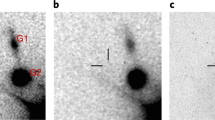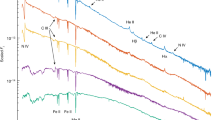Abstract
Nearly 400 years have passed since a supernova was last observed directly in the Milky Way (by Kepler, in 1604). Numerous Galactic supernovae are expected to have occurred since then1, but only one (Cassiopeia A) may have been seen2. The historical record of supernovae is therefore incomplete, as demonstrated by the spatial distribution of young supernova remnants3. The discovery4,5 of γ-ray emission from the decay of 44Ti nuclei associated with Cassiopeia A, the youngest known remnant, has revealed a new way to search for the remnants of other relatively recent supernovae (less than ∼1,000 years old). Here we report the discovery of 44Ti line emission from a previously unknown young supernova remnant, in the direction of the Vela remnant. We estimate a distance of ∼200 parsecs and an age of ∼680 years for the remnant, making it the closest young remnant to the Earth. Why it was not recorded historically remains unknown.
This is a preview of subscription content, access via your institution
Access options
Subscribe to this journal
Receive 51 print issues and online access
$199.00 per year
only $3.90 per issue
Buy this article
- Purchase on Springer Link
- Instant access to full article PDF
Prices may be subject to local taxes which are calculated during checkout


Similar content being viewed by others
References
van den Bergh, S. & Tammann, G. A. Galactic and extragalactic supernova rates. Annu. Rev. Astron. Astrophys. 29, 363–407 (1991).
Ashworth, W. B. Aprobable Flamsteed observation of the Cassiopeia supernova. J. Hist. Astron. 11, 1–14 (1980).
Strom, R. G. “Guest Stars”, sample completeness and the local supernova rate. Astron. Astrophys. 288, L1–L4 (1994).
Iyudin, A. F. et al. COMPTEL observations of 44Ti gamma-ray line emission from Cas A. Astron. Astrophys. 284, L1–L4 (1994).
Iyudin, A. F. et al. in Proc. 2nd INTEGRAL Workshop 37–41 (SP-382, ESA, (1997).
Nomoto, K., Thielemann, F.-K. & Yokoi, K. Accreting white dwarfs models for type I supernovae. III. Carbon deflagration supernovae. Astrophys. J. 286, 644–658 (1984).
Woosley, S. E. & Weaver, T. A. The evolution and explosion of massive stars. II. Explosive hydrodynamics and nucleosynthesis. Astrophys. J. Suppl. 101, 181–235 (1995).
Thielemann, F.-K., Nomoto, K. & Hashimoto, M. A. Core-collapsed supernovae and their ejecta. Astrophys. J. 460, 408–436 (1996).
Woosley, S. E. & Weaver, T. A. Sub-Chandrasekhar mass models for type Ia supernovae. Astrophys. J. 423, 371–379 (1994).
Clayton, D. D., Colgate, S. A. & Fishman, G. J. Gamma-ray lines from young supernova remnants. Astrophys. J. 155, 75–82 (1969).
Dupraz, C. et al. COMPTEL three-year search for galactic sources of 44Ti gamma-ray line emission at 1.167 MeV. Astron. Astrophys. 324, 683–689 (1997).
Schönfelder, V. et al. Instrument description and performance of the imaging gamma-ray telescope COMPTEL aboard the Compton Gamma-Ray Observatory. Astrophys. J. Suppl. 86, 657–692 (1993).
Knödlseder, J. The Origin of 26Al in the Galaxy.Thesis, Toulouse Univ.(1997).
van Dijk, R. Gamma-ray Observations of X-Ray Binaries with COMPTEL.Thesis, Toulouse Univ.(1996).
Oberlack, U. Über die Natur der Galaktischen 26Al-Quellen Untersuchung des 1.8-MeV-Himmels mit COMPTEL. Thesis, München Techn. Univ.(1997).
Diehl, R. et al. 1.809 MeV gamma-rays from the Vela region. Astron. Astrophys. 298, L25–L28 (1995).
Oberlack, U. et al. Implications of the 26Al emission of 1.8 MeV from the Vela region. Astrophys. J. Suppl. 92, 433–439 (1994).
Norman, E. B. et al. Half-life of 44Ti. Phys. Rev. C. 57, 2010–2016 (1998).
Görres, J. et al. Lifetime of 44Ti as probe for supernova models. Phys. Rev. Lett. 80, 2554–2557 (1998).
Aschenbach, B. Discovery of a young nearby supernova remnant. Nature 396, 141–142 (1998).
Weaver, T. A. & Woosley, S. E. in AIP Conf. Proc. 63: Supernovae Spectra (eds Meyerott, R. & Gillespie, G. H.) 15–37 (AIP, New York, (1980).
Schaefer, B. E. Volume-limited sample of supernovae. Astrophys. J. 464, 404–411 (1996).
Acknowledgements
We thank the COMPTEL team for their support. A.F.I. acknowledges support from the German Bundesministerium für Bildung, Wissenschaft, Forschung and Technologie.
Author information
Authors and Affiliations
Corresponding author
Rights and permissions
About this article
Cite this article
Iyudin, A., Schönfelder, V., Bennett, K. et al. Emission from 44Ti associated with a previously unknown Galactic supernova. Nature 396, 142–144 (1998). https://doi.org/10.1038/24106
Received:
Accepted:
Issue Date:
DOI: https://doi.org/10.1038/24106
This article is cited by
-
Searches for continuous-wave gravitational radiation
Living Reviews in Relativity (2023)
-
A signature of cosmic-ray increase in ad 774–775 from tree rings in Japan
Nature (2012)
-
Hard-X-ray emission lines from the decay of 44Ti in the remnant of supernova 1987A
Nature (2012)
-
Supernova remnants: the X-ray perspective
The Astronomy and Astrophysics Review (2012)
Comments
By submitting a comment you agree to abide by our Terms and Community Guidelines. If you find something abusive or that does not comply with our terms or guidelines please flag it as inappropriate.



